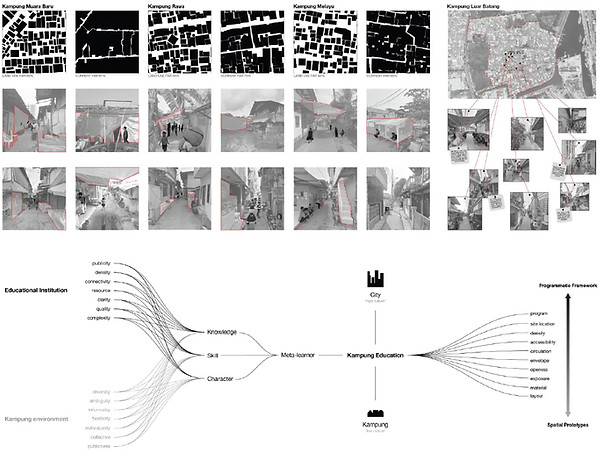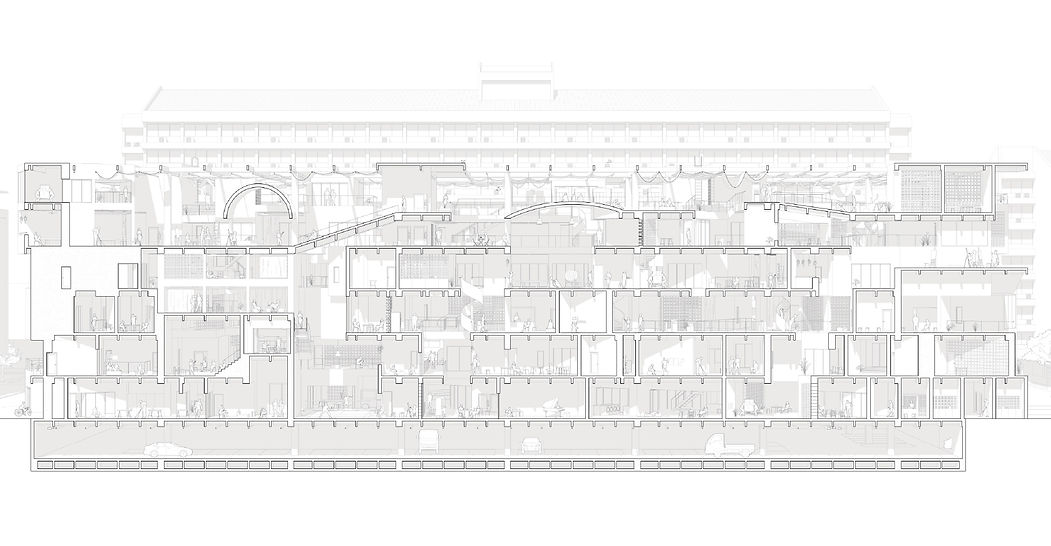Kampung Education
Active Learning through Vernacular Space
2024-2025 // B.Arch Thesis
Advisor: Kane Yanagawa
Education has continuously evolved alongside sociopolitical and technological shifts, progressing from medieval elitism to guild-based apprenticeships, industrial institutions, and now, into the rapidly changing landscape of the information age. A Dell Research Report states that “An estimated 85% of the jobs in 2030 haven’t been invented yet. The pace of change will be so rapid that people will learn “in-the-moment” … thus the ability to gain new knowledge will be more valuable than the knowledge itself,” emphasizing the need for meta-learning(active) over passive knowledge acquisition. Yet, contemporary educational spaces and pedagogies remain rooted in passive engagement and rigid boundaries, limiting learners' ability to adapt to the uncertainty and complexity of modern society.

Kampung Education-Hub model

This thesis extrapolates the uncertainty of societal and technological shifts to assert the relevance of meta-learning(active learning) by implementing a vernacular spatial framework from Jakarta’s Kampung community. The Kampung—known for its diverse, resilient, and informal urban spaces—offers a living testbed for understanding how spatial configurations encourage multiple modes of learning, interaction, and collaboration. By examining the spatial dynamics of the Kampung and its intersection with Jakarta’s formal urban environment, the research seeks to reimagine educational spaces as adaptable, interactive, and integrated with the city.

Jakarta Urban Development (1600s-2030)
This thesis begins with a historical investigation into the evolution of education, tracing how educational philosophies, social revolutions, and architectural typologies have shaped the transmission of knowledge over time. This historical review establishes a foundational framework for understanding the contemporary spatial needs of education.
The second part of the research focuses on the spatial formation of Jakarta’s Kampung settlements. Beginning with the walled planning strategies imposed during the Dutch colonial period, the study examines how informal settlements gradually emerged along the peripheries of these fortified port cities. Influenced by the pressures of modernist urban planning, these settlements evolved into distinct, organic, and self-organized urban forms. This historical context enables a deeper understanding of the spatial logic underpinning the kampung, from which potential strategies can be extracted and reinterpreted for application in contemporary educational architecture.

The third phase of this research involves an in-depth field study of four selected Kampung sites within Jakarta, serving as empirical case studies. These specimens were analyzed through multiple lenses—cultural, social, and architectural—to investigate their spatial organization, floor area ratio (FAR), and the dynamic interplay between built form and communal life. Particular attention was paid to the adaptability of building modules and the fluid interfaces that contribute to the creation of vibrant, dense, and radically informal urban environments.
Through this investigation, the thesis aims to uncover the latent educational values embedded within the spatial fabric of the Kampung. By identifying its potential for self-directed learning, the study proposes a translation of these principles into formal educational contexts—such as campus layouts, academic buildings, and classroom configurations. The objective is to reconcile the so-called “low culture” of the Kampung with the “high culture” of institutional education, thereby generating a new typology of educational architecture—one that is integrative, interactive, and embedded within the life of the city.
Kampung Typology Research

Long Section
Louis Kahn said, “School began with a man under a tree, who did not know he was a teacher, discussing his realization with a few, who did not know they were students.” This thesis, in its entirety, proposes an open-ended idea of creating a new typology of architecture—one that acts as an orchestrated extension of the tree, capable of fostering knowledge and social reproduction. By exposing itself to the city, it transforms learning into an urban lifestyle.

Campus side facade
City side facade






